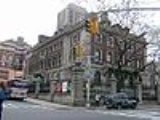
Andrew Carnegie Mansion
Encyclopedia
The Andrew Carnegie Mansion is located at 2 East 91st Street at Fifth Avenue in Manhattan
, New York City
, New York
. Andrew Carnegie
built his mansion in 1903 and lived there until his death in 1919; his wife, Louise, lived there until her death in 1946. The building is now the Cooper-Hewitt, National Design Museum
, part of the Smithsonian Institution
. The surrounding neighborhood on Manhattan's Upper East Side
has come to be called Carnegie Hill. The mansion was named a National Historic Landmark
in 1966.
The Carnegie Corporation gave the house and property to the Smithsonian in 1972, and the modern incarnation of the Cooper-Hewitt Museum opened there in 1976. Hardy Holzman Pfeiffer Associates handled the renovation into a museum in 1977. The interior was redesigned by the architectural firm, Polshek and Partners, headed by James Polshek
, in 2001.
Manhattan
Manhattan is the oldest and the most densely populated of the five boroughs of New York City. Located primarily on the island of Manhattan at the mouth of the Hudson River, the boundaries of the borough are identical to those of New York County, an original county of the state of New York...
, New York City
New York City
New York is the most populous city in the United States and the center of the New York Metropolitan Area, one of the most populous metropolitan areas in the world. New York exerts a significant impact upon global commerce, finance, media, art, fashion, research, technology, education, and...
, New York
New York
New York is a state in the Northeastern region of the United States. It is the nation's third most populous state. New York is bordered by New Jersey and Pennsylvania to the south, and by Connecticut, Massachusetts and Vermont to the east...
. Andrew Carnegie
Andrew Carnegie
Andrew Carnegie was a Scottish-American industrialist, businessman, and entrepreneur who led the enormous expansion of the American steel industry in the late 19th century...
built his mansion in 1903 and lived there until his death in 1919; his wife, Louise, lived there until her death in 1946. The building is now the Cooper-Hewitt, National Design Museum
Cooper-Hewitt, National Design Museum
Cooper–Hewitt, National Design Museum, a subsidiary of the Smithsonian Institution, is the United States' national museum of design history and contemporary design and the only museum in the U.S. whose collection is solely focused on contemporary and historic design...
, part of the Smithsonian Institution
Smithsonian Institution
The Smithsonian Institution is an educational and research institute and associated museum complex, administered and funded by the government of the United States and by funds from its endowment, contributions, and profits from its retail operations, concessions, licensing activities, and magazines...
. The surrounding neighborhood on Manhattan's Upper East Side
Upper East Side
The Upper East Side is a neighborhood in the borough of Manhattan in New York City, between Central Park and the East River. The Upper East Side lies within an area bounded by 59th Street to 96th Street, and the East River to Fifth Avenue-Central Park...
has come to be called Carnegie Hill. The mansion was named a National Historic Landmark
National Historic Landmark
A National Historic Landmark is a building, site, structure, object, or district, that is officially recognized by the United States government for its historical significance...
in 1966.
History
The land was purchased in 1898 in secrecy by Carnegie, further north than most mansions, in part to ensure there was enough space for a garden. He asked his architects Babb, Cook & Willard for the "most modest, plainest, and most roomy house in New York". However, it was also the first American residence to have a steel frame and among the first to have a private Otis Elevator and central heating. His wife, Louise, lived in the house until she died in 1946.The Carnegie Corporation gave the house and property to the Smithsonian in 1972, and the modern incarnation of the Cooper-Hewitt Museum opened there in 1976. Hardy Holzman Pfeiffer Associates handled the renovation into a museum in 1977. The interior was redesigned by the architectural firm, Polshek and Partners, headed by James Polshek
James Polshek
James Stewart Polshek is an American architect based in New York City. He is the founder of Polshek Partnership, the firm at which he was Principal Design Partner for more than four decades...
, in 2001.
See also
- National Register of Historic Places listings in Manhattan from 59th to 110th Streets

